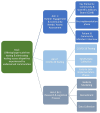Understanding adaptations in a community-vetted COVID-19 testing program
- PMID: 40260233
- PMCID: PMC12009949
- DOI: 10.3389/frhs.2025.1408940
Understanding adaptations in a community-vetted COVID-19 testing program
Abstract
Background: Adaptations are expected when complex public health interventions are implemented in dynamically and rapidly changing real-world settings, as seen for many programs during the COVID-19 pandemic. Systematic documentation of adaptations to intervention components and strategies are critical when assessing their impact on implementation. Here, we report processes used for tracking and evaluating adaptations made during the CO-CREATE project, which aimed to address COVID-19 testing disparities in the San Ysidro US/Mexico border community.
Methods: The study utilized a longitudinal, prospective, mixed methods approach to systematically document and assess adaptations across the pre-implementation, early and mid/late-implementation phases of the project. Aggregated from a combination of sources (i.e., meeting notes, Advisory Board transcripts, and periodic reflections), adaptations were entered weekly into an electronic database that captured information on 16 characteristics and were validated by study staff. The impacts of the adaptations were determined using a team consensus approach and based on the outcomes from the Reach, Effectiveness, Adoption, Implementation, and Maintenance framework. Each adaptation was evaluated to determine whether it increased, decreased, had no effect, or not applicable to the RE-AIM outcomes. Data were analyzed using descriptive statistics.
Results: 98 adaptations were identified, and most were identified by research staff (n = 79, 75.2%). Planned adaptations were defined as those discussed between at least two research team members prior to implementation. Unplanned adaptations were defined as a change made without shared discussion and agreement among at least 2 research team members. Most adaptations were planned (n = 93, 94.9%). Of those that were planned, (n = 21, 22.6%) occurred during pre-implementation, (n = 26, 28.0%) during early implementation, and (n = 46, 49.4%) during mid/late implementation. Of those that were unplanned, (n = 1, 20.0%) occurred during pre-implementation and (n = 4, 80.0%) occurred during implementation. Most adaptations (n = 45, 45.9%) had a positive impact (i.e., increase) on the efficiency of delivery of services, meaningful engagement of partners, and reach of community members through the program.
Conclusion: This work describes our systematic and prospective approach to document and analyze adaptations over a two-year period and assesses the impact of these adaptations. Lessons learned from this work can be used to develop best practices for adapting interventions to ensure sustainable implementation and address disparities in public health and clinical programs.
Keywords: COVID-19 testing; adaptation; border community; community-based; implementation science.
© 2025 Reyes, Tinoco Calvillo, Lomeli, Escoto, Burola, Cain, Salgin, Balbuena-Bojorquez, Engler, Seifert, Laurent, Stadnick and Rabin.
Conflict of interest statement
The authors declare that the research was conducted in the absence of any commercial or financial relationships that could be construed as a potential conflict of interest.
Figures
References
-
- Rabin BA, Viglione C, Brownson RC. A glossary for dissemination and implementation research. In: Brownson RC, Colditz GA, Proctor EK, editors. Dissemination and Implementation Research in Health: Translating Science to Practice. 3rd ed New York: Oxford University Press; (2008). p. 202.
-
- O'Neill J, Tabish H, Welch V, Petticrew M, Pottie K, Clarke M, et al. Applying an equity lens to interventions: using PROGRESS ensures consideration of socially stratifying factors to illuminate inequities in health. J Clin Epidemiol. (2014) 67(1):56–64. 10.1016/j.jclinepi.2013.08.005 - DOI - PubMed






